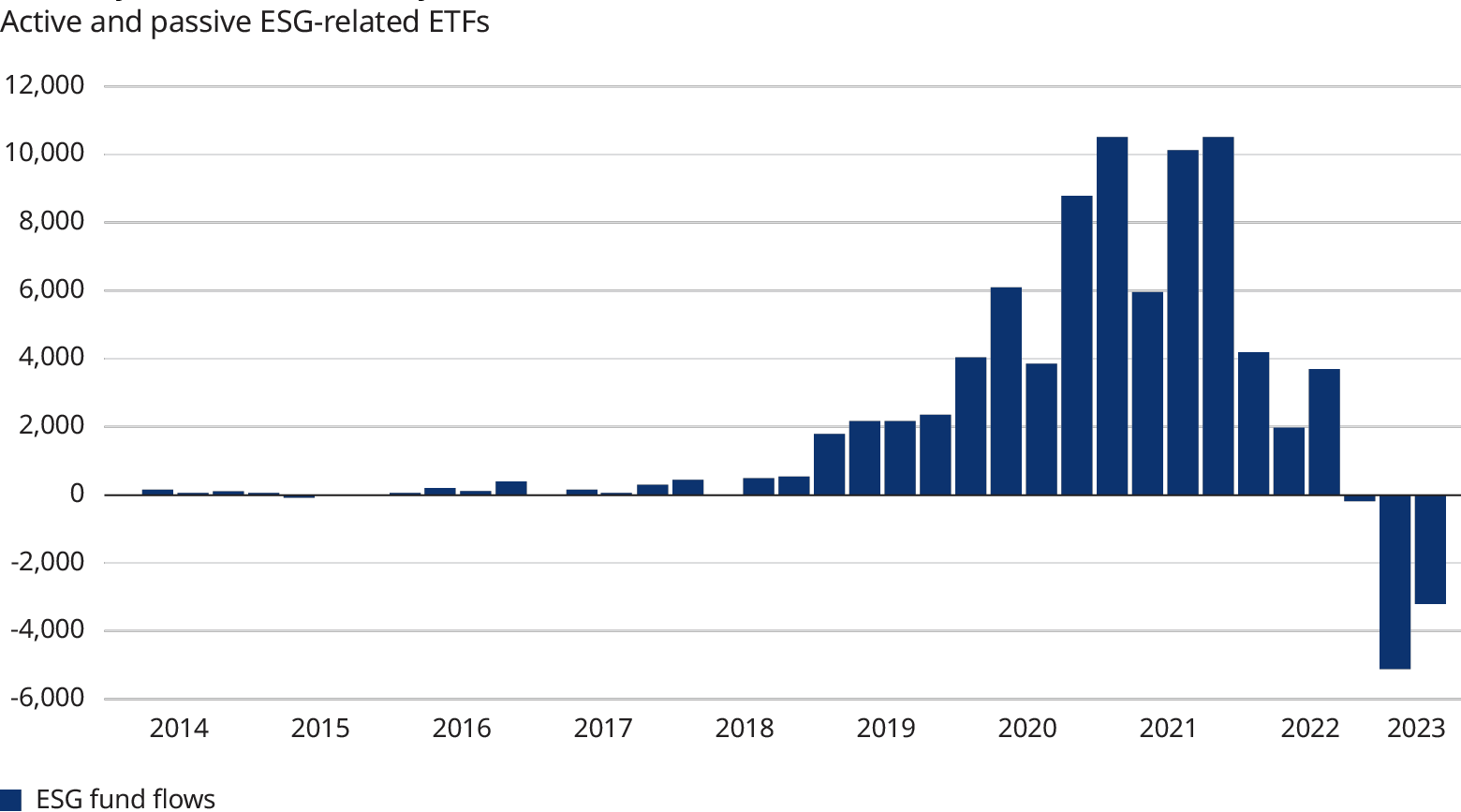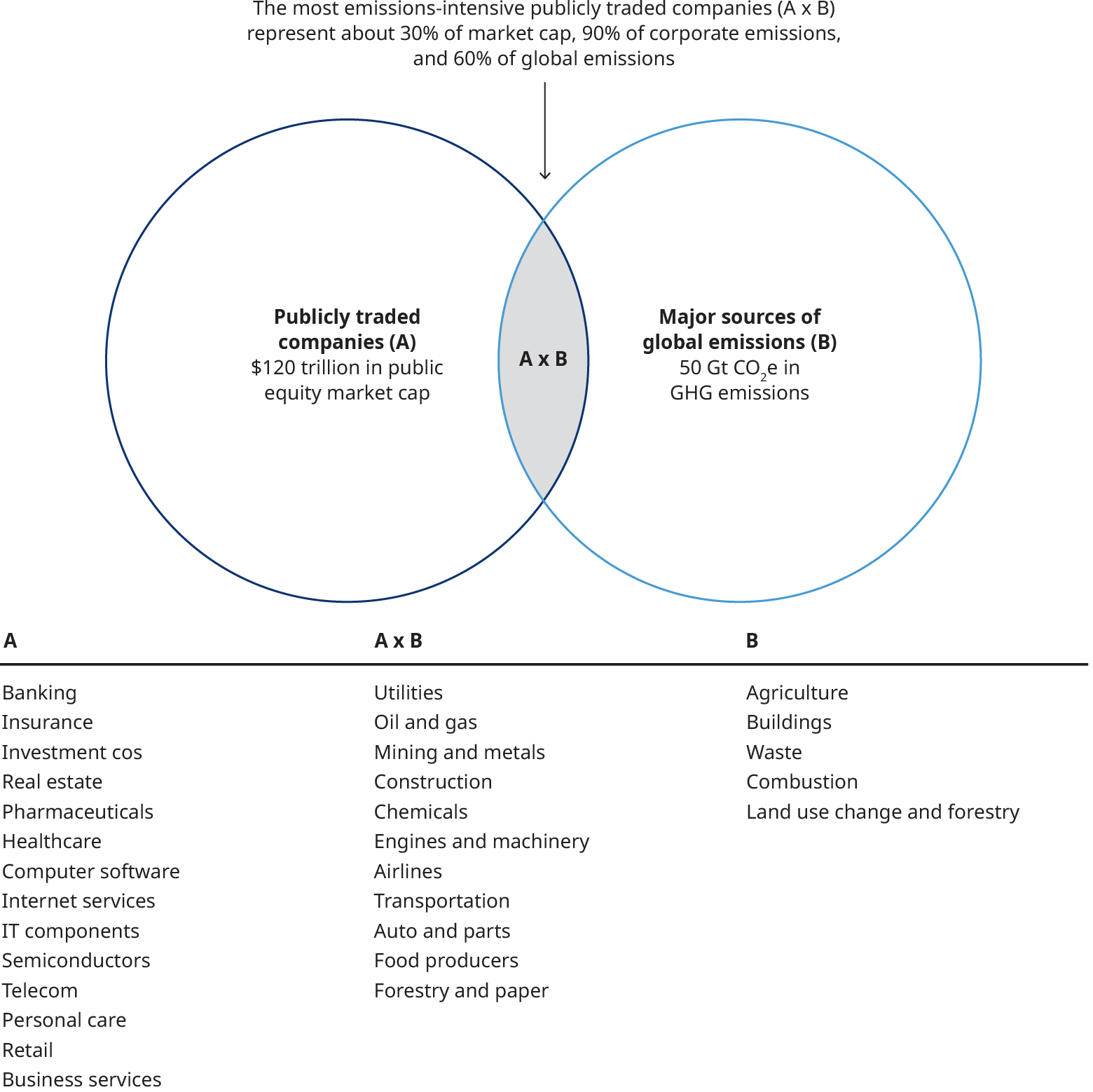This article is an expanded version of an op-ed originally published in The Financial Times in August 2023. Here, we dive into the next phase of climate-aware investing and where the opportunities lie.
How can an investor make good returns and avoid pitfalls from the energy transition? This is arguably one of the most important and contentious questions in finance today.
It’s been a rough year for funds that focus on environmental, social, and governance factors, or ESG. Adverse politics, performance, and product design have all weighed on the sector. Once again, investors have learned the hard way that investing by acronym is never an enduring way to allocate capital — as investors in technology, media, and telecom (TMT) funds and Brazil, Russia, India, and China (BRIC) funds found out.
The next phase of climate-aware investing
Many ESG funds suffered a roughly three to four percentage point underperformance compared with broad equity markets in 2022, according to Oliver Wyman analysis. The underperformance helped prompt investors to undertake a more fundamental review of the investment attributes of ESG portfolios. Many were found wanting or oversimplistic. The exchange-traded fund suffering the highest redemptions globally this year is a fund that tracks ESG “leaders” (ESGU).
Meanwhile, MSCI downgraded 95% of the AAA ratings it had given ESG ETFs this year as it reassessed funds for new regulations.

Source: Morningstar: U.S. Sustainable Fund Flows Contract Again in Q2, but Outflows Ease; Broadridge Global Market Intelligence: Responsible investing ETFs include integration/engagement, best-in-class and positive screening, and exclusions

 Any single, overly simplistic static scorecard of how disparate factors might drive superior investment returns fails to reflect the complexities and nuances of markets
Any single, overly simplistic static scorecard of how disparate factors might drive superior investment returns fails to reflect the complexities and nuances of markets
What’s more, many ESG portfolios have found themselves inflexible to respond to changing market dynamics, such as the impact of the Ukrainian war.
Nevertheless, investors remain keen to weave 21st century risks and opportunities, such as energy transition and energy security, into their portfolios. Give five master chefs the same ingredients and they will produce five distinctive meals. Any single, overly simplistic static scorecard of how disparate factors might drive superior investment returns fails to reflect the complexities and nuances of markets. The Ukrainian war has profoundly shifted public policies, while the Inflation Reduction Act is starting to reshape the global investor narrative.
A flurry of fund launches offers clues to where investors think the next opportunities may lie.
First, investors are increasingly intrigued by "carbon improvers”— firms that are progressively reducing their emissions footprint and generate returns. The first phase of climate-aware investing was to look for firms offering solutions and avoid polluters. But this approach overlooks a key issue.
 Greenhouse gas emissions are highly concentrated in a few key equity sectors that make up about a third of the public equity market
Greenhouse gas emissions are highly concentrated in a few key equity sectors that make up about a third of the public equity market
Greenhouse gas emissions are highly concentrated in a few key equity sectors that make up about a third of the public equity market. These sectors account for about 90% of public company emissions and about 60% of all global emissions, according to Bridgewater Associates. To simply exclude them is self-defeating to real-world decarbonization.

The next generation of climate-aware indices are leaning into forward-looking measures of decarbonization. Take the new MSCI Climate Action Index, launched late last year, which includes estimates of future reduction in emissions. One Finnish pension fund alone has switched $17 billion into funds that track this new index.
Second, there is growing interest in capturing value from investing in companies enabling a faster transition. Brookfield, for instance, hopes to raise $20 billion for its second transition, up from $15 billion from its first one. Meanwhile, BlackRock recently launched a Transition-Enabling Metals ETF. Likewise, General Atlantic and its partners John Browne and Lance Uggla announced an inaugural BeyondNetZero $3.5 billion fund last December to back companies that provide technology to tackle climate change.
That said, there still appears to be a gap in equity funding for new capital-intensive solutions for sectors with hard-to-abate carbon impact. Venture capital, which has been conditioned by free money and tech moonshots, is not yet well set up for this. Also, some new technologies may require longer terms than the typical 10 years of funds. So a new 15-year $1.5 billion fund by Just Climate, a Generation Investment Management firm, is an intriguing development to watch.
Fourth, a handful of institutional allocators are dipping their toes into “impact funds,” which seek to measure not only returns but real-world outcomes. Swedish private equity firm EQT is looking to raise €3 billion — which, if successful, would be the largest ever impact fund in Europe.
And fifth — and most profoundly — energy security and energy transition are being woven into core portfolios. But like all investment themes, there is no one way to do this.
Investors appear to be using more bottom-up data to shed light on specific investment issues, with the use of ESG ratings as a primary tool plummeting, according to a new HSBC survey. Since then, S&P has decided to no longer issue separate ESG scores from debt ratings. Meanwhile, index provider MSCI reported a 40% growth in the second quarter in its climate data subscription business.
Source: HSBC-Survation ESG Survey (June 2023); MSCI Q2 Earnings Call Transcript (July 2023)
Industry use of external ESG ratings from HSBC report is only fixed income ratings as the primary input
Technology, media, and telecom (TMT) funds dominated inflows in the late 1990s but got washed out when the dotcom bubble burst in 2000. Yet today, tech investing has evolved and is deeply embedded. We are likely to see a similar pattern on energy security and decarbonization. Incorporating 21st century risks and opportunities in these areas will become mainstream for investment portfolios.
We are entering a new phase of climate-aware investing
Up until now, investors have been guided by several green rules of thumb. But these may be about to change.
The first phase, before firms started making commitments, was largely thematic: think betting on renewables and being underweight — or excluding — fossil fuels in portfolios.
A second phase has been characterized by net-zero commitments, which have become an important proxy for investors that at the margin can inform the cost of capital. A working paper by US think tank FCLTGlobal suggests that firms issuing green bonds with a net-zero policy enjoyed a 0.08 percentage point “greenium” in terms of better pricing than those that did not. This said, the size of the greenium is much disputed.
But “there are no relationships or equations that always work,” as Barton Biggs, the Morgan Stanley strategist, used to say.
 Climate change has brought a new level of complexity to the scenarios that investors need to weigh up — and new tools are needed
Climate change has brought a new level of complexity to the scenarios that investors need to weigh up — and new tools are needed
Getting it right in this next phase will demand more from investors in terms of data, metrics, risk tolerance, and governance.
Investors will need to shift their focus from a top-down view of the overall sector to a more bottom-up sense of how individual businesses can abate their carbon footprint. This kind of approach will be mirrored by auditors, financial regulators, and customers all seeking more detailed data to hold firms accountable. Part of the new armory will have to be more forward-looking assessments of how well management teams are tackling climate change and which innovations they are relying on. This will allow them to better understand how individual businesses can abate their carbon footprint and accelerate the energy transition. Better data also will enable greater engagement or activism. Some of the most polluting assets are being taken private without any reduction in real-world, actual emissions. This is simply “paper decarbonization.” Investors will need better data and comparable metrics if they are to hold boards accountable. Climate change has brought a new level of complexity to the scenarios that investors need to weigh up — and new tools are needed.




